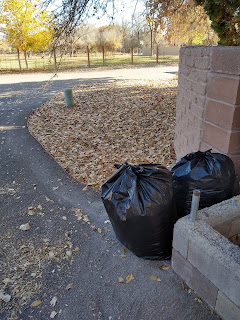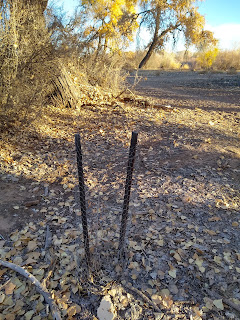The ditch is slowly but surely refilling as the taps somewhere above the Corrales siphon are turned back on. Most people are probably surprised to know that the water passing under the bridge at Andrews Lane started flowing UNDER the Rio Grande at the Siphon and began....somewhere in Bernalillo (I think). Hiking to the source is thwarted at the Pueblo boundary. The river level is also rising. and even a few inches rise allows the ditch water to flow many miles in a flat country.
These songdogs were following the advancing water front along the ditch. I suspect they were looking for rodents flushed out by the water from the newly dug burrows. They stayed out a little too late and got caught out by the early morning dog walkers (me). They MIGHT have been eyeing my dogs as snacks, but my observation was this one stood guard until the smaller ones had escaped, then they all left together for the safety of the bushes. This group of three has stayed in the area, traveling along the bosque paths early in the morning. I have run into them pretty frequently. We nod amicably and both continue on our separate paths.
We have not yet had a hard freeze and many insects are still around in the forest. This (I think) is a tachnid fly, common in the mountains but odd to find down by the river. Scary looking but totally harmless. Especially as the cold mornings mean this fly is basically immobilized until it can reach working temperature. In an emergency (like a person picking it up) it can buzz the wings and generate a little heat, but that will use up precious energy reserves that will be hard to replenish during the winterThis is a very common spider, the Western Parson spider. A ground spider; it hunts at night. They can be found in a house, but not usually. Most people don't realize those long legged skinny "daddy long legs" (Cellar spiders) in the corners of rooms are spider hunters and prey very effectively on the more mobile ground spiders like this one. This picture shows off the "necktie" pattern on the abdomen. These spiders prefer wooded area and are often found in the leaves of fall.
Honey bees should be hibernating by now, but this one at the local pizza joint was still out. Often bees will eject members of the hive to reduce the depletion of winter food stores. Usually the non-productive drones are thrown out to starve, but this looks to be a young female. There are no pollen in the hair sacs on the legs. After I gave her some sugar water, she went back into the cracks of the building, hopefully as part of an escaped swarm setting up in a new location. Bees have been domesticated for about 9,000 years. The western honey bee is not native and appears to have originated in Africa and is now mostly bred in southern states in a highly commercialized market.
I succumbed to neighborhood peer pressure and raked up the leaves in the yard. I have the misfortune of understanding that this is a bad thing. Those leaves on the ground do so much for the local wildlife. When combined with piles of wood, they are a habitat for all sorts of life. They are nurseries for plants, fungus, insects, mammals. They ameliorate the soil, regulate the micro climate of the ground, hold in moisture and add acidity and nutrients. They shelter larval and burrowing creatures. They feed crickets and the spiders that prey on those creatures. They hide burrow entrances and provide bedding to the animals in those burrows. The fungus that lives on this leaf substrate feed moths that the vibrant towhee and robins spend the winters hunting for. The dead leaves prevent young cottonwood tree saplings from freezing when the frosts come.
This plant is mock vervain and is bright burst of color in the otherwise dull woods. Insects are not really feeding much right now, but there are many species that could survive on the nectar this flower offers.
Oddly, my app had some trouble identifying this plant that stood out in the Romero Trailhead burn scar area. All the plants, shrubs and trees in the area are exfoliated, but there were a couple of bright green patches of this plant that stood out. I'm pretty sure it isn't NM olive.
Next to that soil bank erosion, the wooded area had been planted with a willow species (probably Gooding's). This species of tree has shallow roots and needs access to water. For whatever reason, the water table is too deep for these plants to become established. None of the planted trees (identified by this anti-beaver chicken-wire screen) appear to have survived. The invasive tamarisk trees are so insidious because they draw down the water table locally, killing seedlings whose species are adapted to easy access to groundwater, like cottonwoods and willows.
Notice the dangling legs of this porcupine the legs should be tucked up into the body. It is actually dead and has been for a while. The face on this individual (zooming in) had been attacked by some sort of pathogenic fungus. Other photographers have seen this same individual, but not looked into it much. Alarmingly, there appears to be reports on the east coast of a deadly fungal outbreak spread to porcupines from domestic pets. But mortality events related to starvation seem to happen to porcupines often during the winter as these slow animals face increased stressors at a time when the food available (bark) is of a low quality. Fungal infections have affected many animals , such as snakes, and frogs. Often the cause is linked to people's activities such as the pet trade (frogs imported from South east Asia brought chytrid fungus to Central American populations). Dogs and cats often transmit diseases like ringworm to wild animals. These diseases often are not noticed in the pets who are warm and well fed, but can be lethal to a native wild population facing hunger and cold conditions normally.












No comments:
Post a Comment